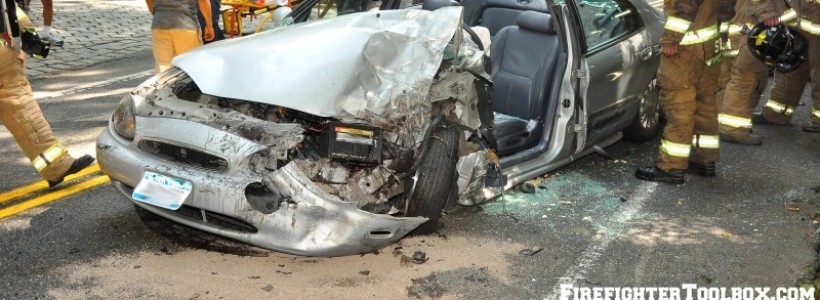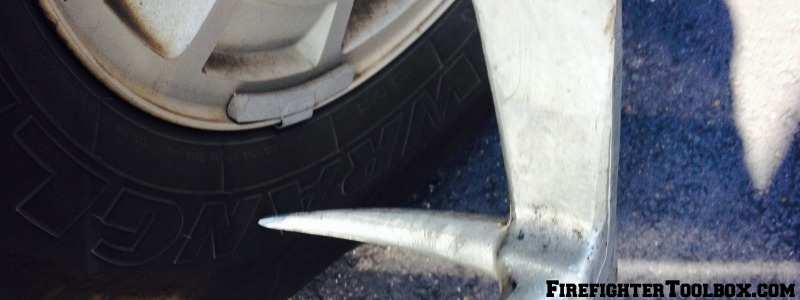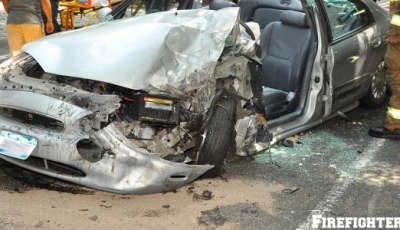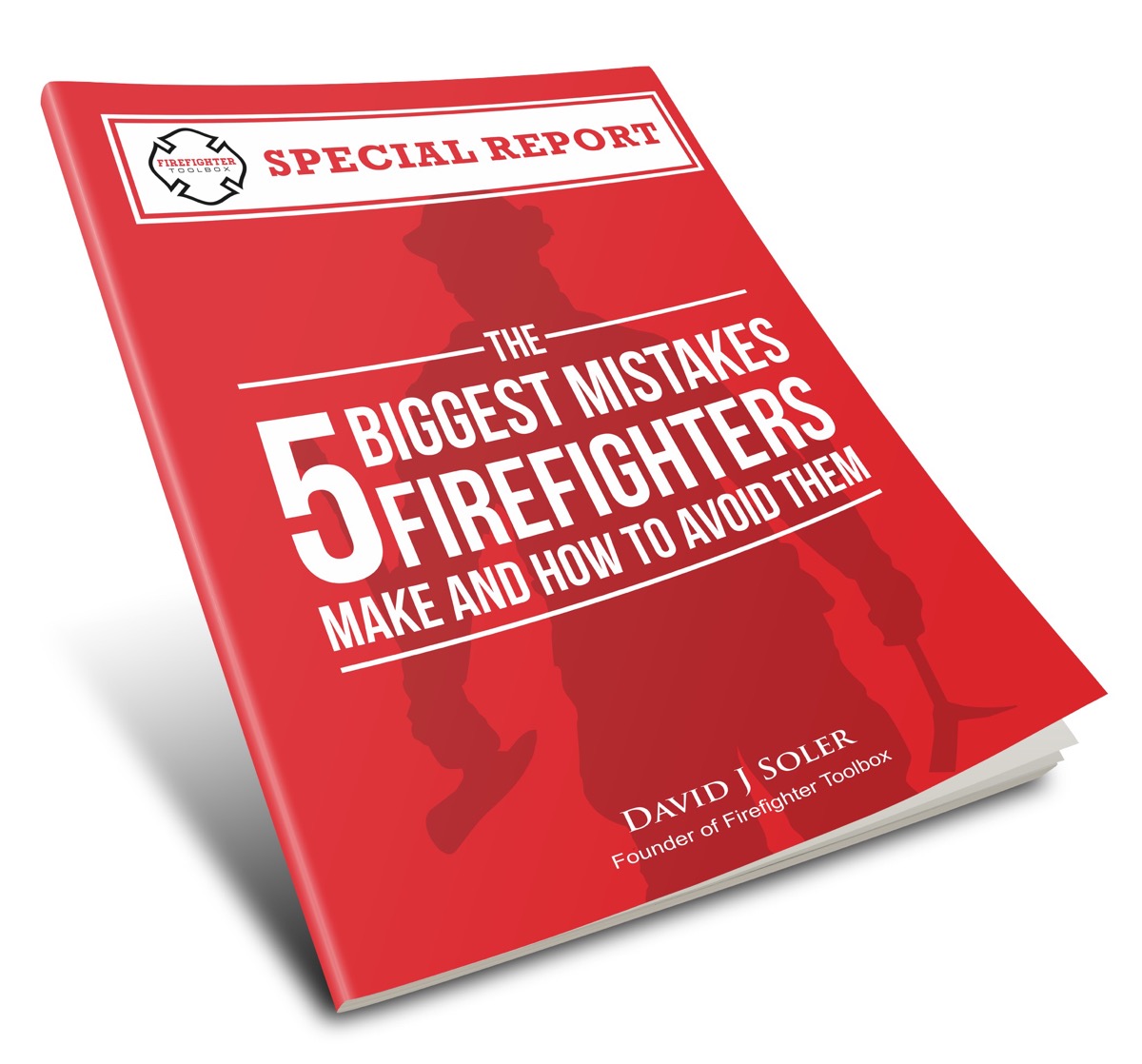8 Fundamentals of Extrication – Part 1
Motor vehicle accidents (MVAs) are a common response for us in the fire service. Many times these incidents involve injuries and frequently are more of an EMS response than fire. We may secure the vehicle’s power, protect the scene with our apparatus and apply an absorbent to spilled fluids. However, there is a percentage of cases that involve a trapped patient that we must extricate.
You may or may not get to frequently use extrication equipment. Your department may have a dedicated rescue company or the truck company may carry and use the extrication equipment. If you arrive on scene of a motor vehicle accident involving entrapment with or without extrication equipment, there are some things that need to get taken care of before “the cutting” can begin. Let’s take a look today at the first 4 fundamentals.
#1 – Arrival
Arrival at a motor vehicle accident should involve placing the apparatus in a position that will safely protect you and your crew while you operate. Generally we like to position our apparatus at an angle, pushing the traffic away from us. The actual positioning of the apparatus is outside the scope of this article; an entire series can probably be written on the subject.
For me, if you need to shut down the road, shut it down. If you need to shut down a lane then do so. It is no secret that when motorists view an accident, their eyes are everywhere but the road. Do what you have to do to keep yourself safe.
#2 – Size-Up
Just as we do at all fire alarms, we should conduct a thorough scene size-up when we arrive at a motor vehicle accident. Especially with today’s vehicles and the advent of hybrid as well as alternative fuel vehicles, it is imperative that we know what we are getting ourselves into. Some of the things we need to ask ourselves are (but are not limited to):
- Is the scene safe for us to enter?
- Are there any obvious hazards that we need to deal with?
- How many vehicles are involved?
- What is the condition of the vehicles involved?
- What is the stability of the the vehicles?
- How many patients do we have and is there any obvious immediate life threats that need to be managed (airway, bleeding, etc.)?
- Do we need to call additional resources?
#3 – Safety Line & Extinguisher
It is always good practice to stretch an inch-and-three-quarter protection line and to have a dry chemical extinguisher handy as well. Fire can break out at any time.
#4 – Secure The Vehicles
To keep the vehicles stable, it is advisable to chock the tires. This can be done by many methods some of which are:
Step Chocks – Step chocks work well as they can chock the vehicle underneath the body and can be used on vehicles of different heights very easily. If you need to push or lift the dash later on, it will also give you something to push against where the body of car will not be able to push down.
Chocks From The Apparatus – If you do not carry a variety of chocking or cribbing on your apparatus, the vehicle can be held in place with the chock off your apparatus.
Halligan Tool – If you take the pike of the Halligan, you can flatten a tire easily. Or, with a pair of wire cutters you can also take the tire valve and flatten the tire that way. Tow truck drivers just love when you flatten the tires by the way!
Make Certain The Vehicle Is In Park – Check the inside of the vehicle to ensure the vehicle is in park; also make sure the ignition is switched off. If the vehicle you are operating with has Smart Key technology, make sure the key is removed from the vehicle and kept at least twenty feet away.
Next time we will cover the last four fundamentals of a safe extrication operation.
If you have any other tips in addition to these please leave them in the comment section.
Photos courtesy of Steve Silverman and Rob Fling.






In the picture, is that step chock the right way up? Wedged in that way it could easily fire out or the car slide off it. Personally I would have placed the chock under the car with the largest surface facing down and the step stepped into the sill, then deflated the tires so that the car sat down onto the chock. Isnt that a better method of placing the chock?
Yes it’s actually common practice to position step cribbing that way. Some cars don’t fit neatly onto the step portions and flipping it upside down presents a smooth surface to then drive a triangle wedge between the wood and the bar to take up the extra couple inches. It’s not used to lift the car off the ground however just for stabilizing so the wheels remain in contact with the ground. Otherwise you would be correct in saying the car would slip.
Yes it’s actually common practice to position step cribbing that way. Some cars don’t fit neatly onto the step portions and flipping it upside down presents a smooth surface to then drive a triangle wedge between the wood and the bar to take up the extra couple inches. It’s not used to lift the car off the ground however just for stabilizing so the wheels remain in contact with the ground. Otherwise you would be correct in saying the car would slip.
I have read and suggest that immobilization and stabilization of a vehicle should be 2 different steps. Immobilization should be conducted first by first on scene units. It might include putting car in PARK, deploying hand brake, shutting ignition or possibly even placing apparatus bumper to bumper with vehicle. This should happen before access for EMS is allowed. stabilization can occur later if/when required using various methods. This has become more important with “silent running” hybrid/electrics! IMHO only.